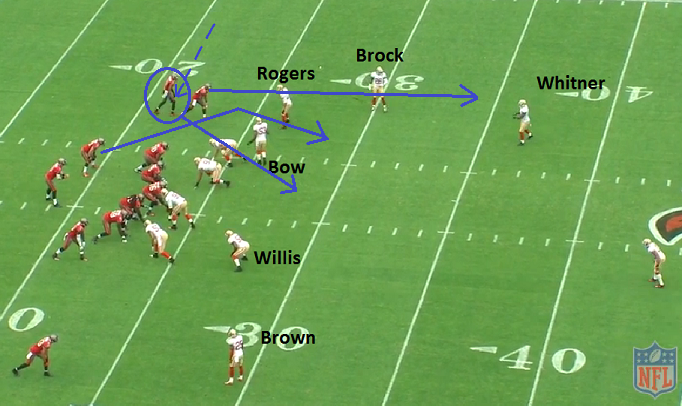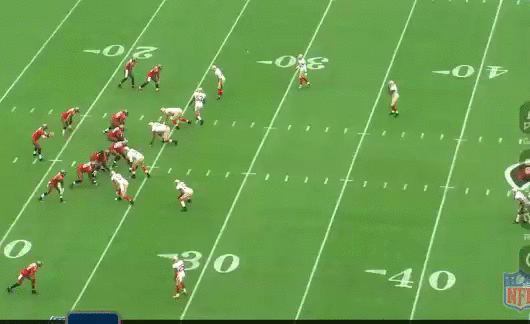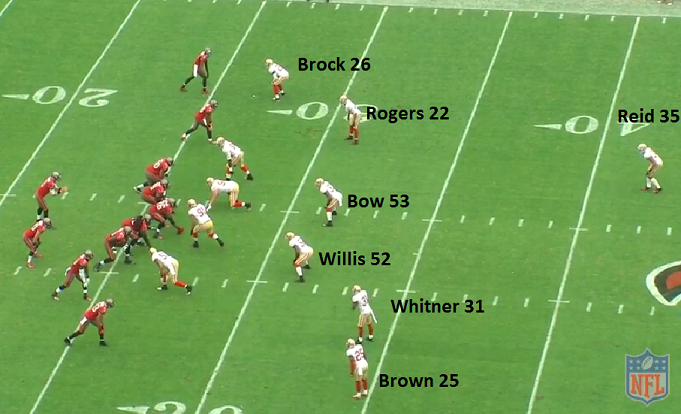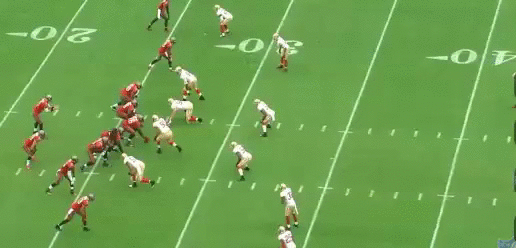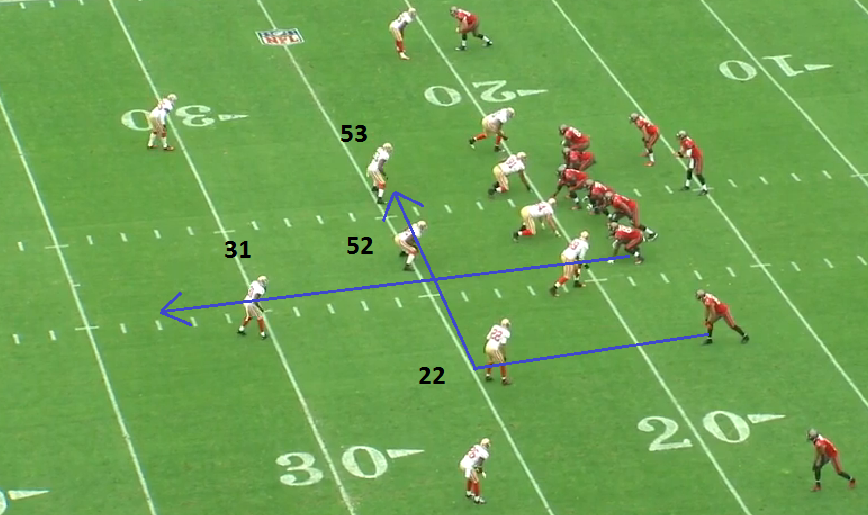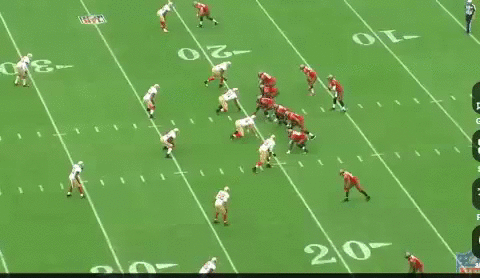Originally posted by thl408:
Originally posted by jonnydel:
Thanks Thl for picking up the slack while I was gone. You added a lot of great stuff! Thanks. I do think, however, that we incorporate progression reads in our coverage reads.
From what I could see on film, and the way Kaep was checking plays, it seemed like they would have a certain zone buster(like a cover 3 buster for example) and with a phrase he could check to a cover 2 bust. Or sometimes a zone buster to a man buster. There were several times(particularly when Tampa stopped us) that Tampa showed somethine pre-snap, Kaep changed the routes, Tampa changed their D and got themselves into a favorable defense.
I'll show in a few minutes how Kaep also did a great job in his scouting recognition to get us into some favorable run plays.
Hope all is okay with pops jonnydel. I link a progression read directly to footwork. Also, it is pre-determined by the playcall which target the QB looks to first. After the QB snaps the ball, during mid-dropback, he is reading the coverage technique used by the CB on that WR (his #1 read). If the WR is running a route that wins against that leverage and technique (coverage), throw it on the completion of the dropback. If during mid dropback, the #1 WR is covered, the QB looks to his #2 and uses the same analysis of leverage and technique. Coverage reads are where the QB can look first to whichever route he feels is right based off his pre-snap read. Good footwork never hurts, but does not need to be precise. I'd like to take a guess at what you meant in the bolded, and hope you expand on it. I'm guessing what you mean is that when the 49ers call a generic pass play, designed to beat both man on one side and zone on the other, Kap is timing his footwork with his #1 and #2 read on that certain route concept. If that concept is defeated, his footwork takes him to the other concept being run on the other side of the field.
During the live telecast, they rarely show the defensive backfield, where less players are and it's easier to see what's going on. Instead, they focus on the front 7 and OL, where there is so much going on and it's impossible to really see it all. Thanks for the breakdowns near the line of scrimmage. Looking forward to more.
jonnydel,
First off, I'm so sorry for what you and your father and family are going through right now...the fact that you are staying home to take care of him brings images of Eric Reid and his daughter on draft day. Family, its what it's all about. So I'm sending my best to you all (as we all are, I'm sure).
As far as this thread goes, for a couple years now, a poster by the name of whomeam provided the actual games for everyone but unfortunately, fans didn't take advantage to discuss what they were "seeing." THIS thread has helped bring back real quality discussions based on visual evidence. I also really appreciate you focusing on the defense this round as often times, they get ignored and they too, have some weaknesses like any unit does (I also like that you focus on stellar play as well).
That said, I fundamentally disagree with you and thl408 on some levels with this passing game:
1. I think you both may be focusing way too much on defensive coverage schemes. This is HaRoMan here...they don't care if a defense stacks 10 in the box, we're running it if that is the play called in the huddle (obviously). The focus is on "execution;" you've heard it a million times. Why would this be any different in the passing game? In my (college-like) AR theory, it doesn't matter what the defensive alignment is, if the AR beats his man and the non-AR's execute their parts, the play will work. Period. And that is what I'm seeing here. It's a team receiving concept. Roman himself talks about if one piece of the chain breaks down, the whole play breaks down. That applies to the running game AND the passing game. We saw the results from game 2 up until 2 weeks ago when Manningham and Crabtree came back. Now defenses can no longer double up on the two AR's in VD and Boldin while run blitzing between the tackles to stuff Gore...they now have to contend with Crabtree and Manningham leaving someone (maybe two) 1on1. And we're going to win the mass majority of the 1on1's now with top-notch talent. It's simply a team receiving concept and if CK does not pull the trigger under the 3 second mark (or the AR is covered), CK is off and running (usually to his right) to buy time to ad lib pass or pick up yards with his legs.
2. We need to look at who WE are as a team. We have a college coach and college running back coordinator who is our OC now and 6 different staff members contribute to not only the game plan but in-game compartmentalized play calling. And it lacks the "flow" and rhythm as a result at times. This is a coaching staff that wants total control of every play they call in to the huddle. CK, to me, is nothing more than an extension of the play called in. This is why Harbaugh and Roman said they don't understand all the criticism towards CK in the media as a "one-read QB" or a "remedial QB" when the first read is covered. He is doing EXACTLY what they ask of him while still recognizing he's green in many many areas. We do NOT run a traditional or modern day version of a WCO (high-to-low progressions) or Spread offense (left-to-right or vice versa usually) here. In fact, a WCO expert in Jon Gruden defined this offense as, "I don't know WHAT the heck this offense is..." It's the big mystery...some PS plays, some Chris Ault Q-formations, some WCO running plays, etc.? Who knows! Nobody does...and we don't know how complex it is. Like a WCO, will it take 3+ years to master or longer? Or is "mastery" not required like in a college offense?
3. I do agree with thl408 in that there are no progression reads built in to this passing game except when we run a pro-style passing route and this is usually dictated by a 4 WR set (the dead give-away). Here you can clearly see all 4 receivers (usually a TE mixed in there as a WR and all backs run out in the flats as outlets) and all are viable receiving options and it's on CK to pull the trigger on the best option. These are rare plays though, maybe a handful a game but we're seeing more and more (good sign as it puts more into CK's trust by the coaches; if he converts, maybe we'll see more).
4. Another factor to consider that is critical to all of this is that CK generally only has less than 5 seconds to get off the play. This would instantly debunk the theory that he is at the LOS reading defensive alignments, making audibles, changing the play, realigning his receivers and backs to target better matchups, etc. How many times have we seen us run right into a brick wall with 10 in the box and a 1on1 matchup outside with Boldin? CK is executing the play call. My guess is that in these cases he is given two running plays to choose from and he is not given the freedom to audible out to a passing play. B/c what pro QB wouldn't check out here to Boldin? This is the same play that Boldin beat Rogers on that crtical 3rd down in the Superbowl. Flacco checked out of the running play to Boldin. Win.
5. I do subscribe to thl408's idea that when given time, CK does read coverages and audibles to the best matchup BUT from the plays called in to the huddle by the coaches...you can see him motioning to a FB to split out wide or realigns the backfield, has a WR come in motion, etc. In the end though, I still think he is checking into 1 of 2 plays called in by the coaching staff and in each play, the AR concept is still the foundation (primarily). This is why Boldin said himself that some game plans he's the AR and other times he's asked to "block more" and that he accepts his "role" in this offense. This is similar to Moss's (role) last year with us as the deep sideline and deep post decoy (occupies 2 DB's) to open up Crabtree and VD underneath (the two AR's from last year). Moss was also quoted as saying the same thing as Boldin and he too accepted his role.
6. As to the frustration with HaRoMan by fans, you have to understand that that really extends to the entire coaching staff as a whole (b/c they all have their part in it). We've seen WAY too many obvious patterns to ignore now under two polar-opposite QB's to date under the same personnel. If you're still having the same exact issues, then THAT is on coaching, offensive philosophy and scheme/proper personnel usage. No coaching staff has gotten so little out of so much talent in the NFL. A true OC shows his colors when there is some adversity (Crabtree/Manningham off season injuries and now, the /Miller injury) or when a defense is taking your two AR's away (Boldin and VD). To me, Roman has shown a total lack of ability to adjust other than to go to Gore (bell-cow) for 6 straight games. No other players were incorporated into the game plan and/or developed along the way to counter defensive game plans to take away the AR's; quality playoff defenses destroyed the game plans while we beat up on teams with lesser personnel. HaRoMan are competely reliant upon having all-pro talent at every level to be remedial at best. There are just too many patterns to ignore now esp. when you look beyond the 49ers and all the success former Niners are having (Teddy Ginn, Alex Smith, etc) and the countless in-season injuries other OC's had to endure on-the-fly. We had ALL off season to compensate for Crabtree/Manningham and all season to develop other weapons that defenses had to account for. Not only have other OC's they risen above this adversity but risen above it with no-name players. THAT is proper offensive philosophy, coaching, development and game planning. On the whole, I can probably speak for many here and say that the HaRoMan et. al-team is solid; they are not the worst in the NFL by any means. We'll continue to win the mass majority of the games on talent alone. But when it comes to the playoffs and Superbowl, when everything is magnified and weaknesses are exploited, does anyone genuinely feel like on an even playing-field of talent (now that we have a "full arsenal"), this coaching staff is going to outcoach the opposition and exploit weaknesses and BE the difference in the game? I think if you can answer that honestly, you can understand the frustration here with many fans (and probably Baalke/Jed themselves).
[ Edited by NCommand on Dec 18, 2013 at 8:19 AM ]



